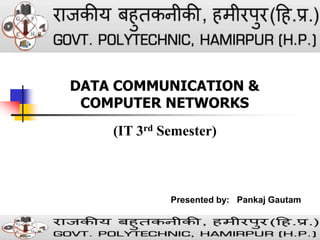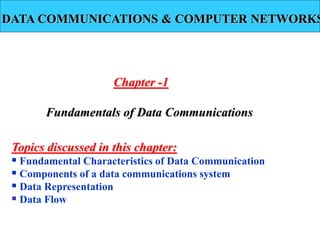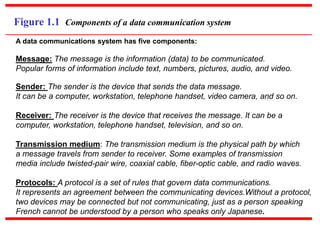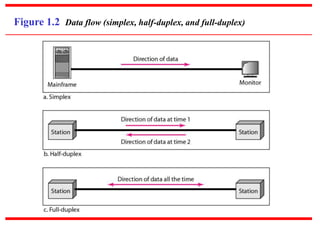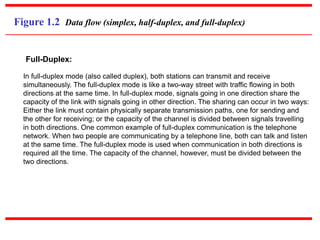Introduction to Data Communication
- 1. McGraw-Hill ┬®TheMcGraw-HillCompanies,Inc., 2000 DATA COMMUNICATION & COMPUTER NETWORKS Presented by: Pankaj Gautam (IT 3rd Semester)
- 2. DATA COMMUNICATIONS & COMPUTER NETWORKS Fundamentals of Data Communications ’é¦ Fundamental Characteristics of Data Communication ’é¦ Components of a data communications system ’é¦ Data Representation ’é¦ Data Flow Topics discussed in this chapter: Chapter -1
- 3. DATA COMMUNICATIONS The term telecommunication means communication at a distance. The word data refers to information presented in whatever form is agreed upon by the parties creating and using the data. Data communications are the exchange of data between two devices via some form of transmission medium such as a wire/cable. For data communications to occur, the communicating devices must be part of a communication system made up of combination of hardware (physical equipment) and software (programs).
- 4. DATA COMMUNICATIONS : CHARACTERISTICS The effectiveness of a data communications system depends on four fundamental characteristics: delivery, accuracy, timeliness, and jitter. 1. Delivery. The system must deliver data to the correct destination. Data must be received by the intended device or user and only by that device or user. 2. Accuracy. The system must deliver the data accurately. Data that have been altered in transmission and left uncorrected are unusable.
- 5. DATA COMMUNICATIONS : CHARACTERISTICS 3. Timeliness. The system must deliver data in a timely manner. Data delivered late are useless. In the case of video and audio, timely delivery means delivering data as they are produced, in the same order that they are produced, and without significant delay. This kind of delivery is called real- time transmission. 4. Jitter. Jitter refers to the variation in the packet arrival time. It is the uneven delay in the delivery of audio or video packets. For example, let us assume that video packets are sent every 30 ms. If some of the packets arrive with 30-ms delay and others with 40-ms delay, an uneven quality in the video is the result.
- 6. Figure 1.1 Components of a data communication system
- 7. Figure 1.1 Components of a data communication system A data communications system has five components: Message: The message is the information (data) to be communicated. Popular forms of information include text, numbers, pictures, audio, and video. Sender: The sender is the device that sends the data message. It can be a computer, workstation, telephone handset, video camera, and so on. Receiver: The receiver is the device that receives the message. It can be a computer, workstation, telephone handset, television, and so on. Transmission medium: The transmission medium is the physical path by which a message travels from sender to receiver. Some examples of transmission media include twisted-pair wire, coaxial cable, fiber-optic cable, and radio waves. Protocols: A protocol is a set of rules that govern data communications. It represents an agreement between the communicating devices.Without a protocol, two devices may be connected but not communicating, just as a person speaking French cannot be understood by a person who speaks only Japanese.
- 8. Figure 1.2 Data flow (simplex, half-duplex, and full-duplex) Communication between two devices can be simplex, half-duplex, or full-duplex. In simplex mode, the communication is unidirectional, as on a one-way’üČ street. Only one of the two devices on a link can transmit; the other can only receive. Keyboards and traditional monitors are examples of simplex devices. The keyboard can only introduce input; the monitor can only accept output. The simplex mode can use the entire capacity of the channel to send data in one direction. Simplex: Half-Duplex: In half-duplex mode, each station can both transmit and receive, but not at the same time. When one device is sending, the other can only receive, and vice versa. The half-duplex mode is like a one-lane road with traffic allowed in both directions. When cars are travelling in one direction, cars going the other way must wait. In a half-duplex transmission, the entire capacity of a channel is taken over by whichever of the two devices is transmitting at the time. The half-duplex mode is used in cases where there is no need for communication in both directions at the same time; the entire capacity of the channel can be utilized for each direction
- 9. Figure 1.2 Data flow (simplex, half-duplex, and full-duplex)
- 10. Figure 1.2 Data flow (simplex, half-duplex, and full-duplex) In full-duplex mode (also called duplex), both stations can transmit and receive simultaneously. The full-duplex mode is like a two-way street with traffic flowing in both directions at the same time. In full-duplex mode, signals going in one direction share the capacity of the link with signals going in other direction. The sharing can occur in two ways: Either the link must contain physically separate transmission paths, one for sending and the other for receiving; or the capacity of the channel is divided between signals travelling in both directions. One common example of full-duplex communication is the telephone network. When two people are communicating by a telephone line, both can talk and listen at the same time. The full-duplex mode is used when communication in both directions is required all the time. The capacity of the channel, however, must be divided between the two directions. Full-Duplex:
